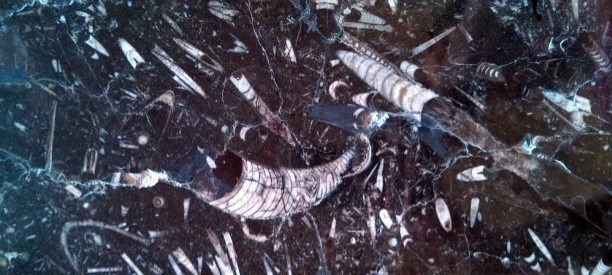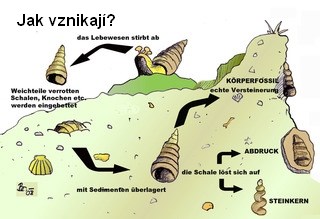|

 Tato EarthCache vám ukáže stěnu s desítky otisky živočicha Orthoceras. Tato EarthCache vám ukáže stěnu s desítky otisky živočicha Orthoceras.
 This EarthCache will show you a wall with many fossils of "Orthoceras". This EarthCache will show you a wall with many fossils of "Orthoceras".

Orthoceras
 Orthoceras byl největší známý hlavonožec. Mohl mít až dvanáct chapadel kolem svého zobanu s ostrými hranami. Drtil jím svou kořist. Jeho výtanou potravou byly velcí trilobiti např. Isotelus a takzvaní mořští štíři neboli kyjonožci. Orthoceras měl pravděpodobně malé oči, protože žil ve velkých hloubkách. Nepronikalo tam moc slunečního svitu, proto nepotřeboval dobře vidět. Jeho hlavní smysl byly stejně jako u medvěda ledního, čich. Orthoceras je jedním z nejdéle žíjích tvorů v geologické historii země. Zbytky jeho "ulity" (která tvořila skoro celé jeho tělo) jsou nalézány od doby před 488 mil. let až do začátku jury před 199 mil. let. Schránka tohoto hlavonožce byla rozdělena na komory. V jejich středu byla dlouhá trubice vyplněná vzduchem. To pomáhalo k tomu, aby živočich nevyplaval na hladinu, tedy ho to udržovalo ve stálé pozici. Orthoceras byl největší známý hlavonožec. Mohl mít až dvanáct chapadel kolem svého zobanu s ostrými hranami. Drtil jím svou kořist. Jeho výtanou potravou byly velcí trilobiti např. Isotelus a takzvaní mořští štíři neboli kyjonožci. Orthoceras měl pravděpodobně malé oči, protože žil ve velkých hloubkách. Nepronikalo tam moc slunečního svitu, proto nepotřeboval dobře vidět. Jeho hlavní smysl byly stejně jako u medvěda ledního, čich. Orthoceras je jedním z nejdéle žíjích tvorů v geologické historii země. Zbytky jeho "ulity" (která tvořila skoro celé jeho tělo) jsou nalézány od doby před 488 mil. let až do začátku jury před 199 mil. let. Schránka tohoto hlavonožce byla rozdělena na komory. V jejich středu byla dlouhá trubice vyplněná vzduchem. To pomáhalo k tomu, aby živočich nevyplaval na hladinu, tedy ho to udržovalo ve stálé pozici.
 Orthoceras was the most famous cephalopod. He could have twelve tentacles around his beak with sharp edges. He crushed his prey. His food was a great trilobite, for example, Isotelus and the so-called sea scorpions or kyjonožci. Orthoceras probably had small eyes because he lived in great depths. There was not much sunshine there, so he did not need to see well. His main sense was, like a polar bear, a smell. Orthoceras is one of the longest living creatures in the geological history of the country. The remains of his "shell" (which formed almost his entire body) are found from 488 million years ago to the beginning of the jury 199 million years ago. The box of this cephalopod was divided into chambers. In their center was a long tube filled with air. This helped the animal not to float, so it kept it in a steady position. Orthoceras was the most famous cephalopod. He could have twelve tentacles around his beak with sharp edges. He crushed his prey. His food was a great trilobite, for example, Isotelus and the so-called sea scorpions or kyjonožci. Orthoceras probably had small eyes because he lived in great depths. There was not much sunshine there, so he did not need to see well. His main sense was, like a polar bear, a smell. Orthoceras is one of the longest living creatures in the geological history of the country. The remains of his "shell" (which formed almost his entire body) are found from 488 million years ago to the beginning of the jury 199 million years ago. The box of this cephalopod was divided into chambers. In their center was a long tube filled with air. This helped the animal not to float, so it kept it in a steady position.

Fosilie/Fossils
 Fosilie jsou pozůstatky pravěkých organismů, které se nám dochovaly do současnosti. Zkamenělinou (tzv. fosilií) může být jak otisk v kameni (nepravá fosilie), tak kosti dinosaurů, či zkamenělé kmeny dávných stromů. Za fosilii je považován jakýkoliv, ať už celý, anebo neúplný pozůstatek živočišného či rostlinného původu starší více než 10 000 let (Pleistocén a dříve). Pozůstatek nám musí však podávat alespoň základní představu o tvaru a stavbě pravěkého organismu. Fosilie jsou tedy hmotné doklady existence života, který byl v geologické minulosti na naší planetě. Fosilie jsou pozůstatky pravěkých organismů, které se nám dochovaly do současnosti. Zkamenělinou (tzv. fosilií) může být jak otisk v kameni (nepravá fosilie), tak kosti dinosaurů, či zkamenělé kmeny dávných stromů. Za fosilii je považován jakýkoliv, ať už celý, anebo neúplný pozůstatek živočišného či rostlinného původu starší více než 10 000 let (Pleistocén a dříve). Pozůstatek nám musí však podávat alespoň základní představu o tvaru a stavbě pravěkého organismu. Fosilie jsou tedy hmotné doklady existence života, který byl v geologické minulosti na naší planetě.
Fosilie jsou pozůstatky po organismech z geologické minulosti, které se dochovaly do současnosti. Aby k něčemu takovému mohlo vůbec dojít musí nastat určité podmínky a pochody, které umožní a způsobí vznik fosilií a tím i zachování pozůstatků uhynulých organismů.
Fosilie vznikají na různých místech, kde jsou podmínky pro jejich zachování. Samotný způsob vzniku fosilie může mít také různé podoby, ale cílem je uchránit zbytek či pozůstatek po organismu před rozložením či zničením.
Ačkoliv to možná vypadá, že fosilií je obrovské množství (zejména na některých lokalitách) je vznik zkameněliny spíše výjimečný. Většina pozůstatků živých organismů má jen velmi malou šanci, že dojde k jejich zkamenění - spíše dojde k jejich nenávratnému zničení.
Podmínky pro vznik fosilií jsou skutečně velmi náročné a tak nám zkameněliny ukazují jen část života v pravěku. Tam kde nebyly příhodné podmínky pro vznik fosilií nám informace prostě chybí. Při práci se zkamenělinami musíme mít vždy na mysli, že pracujeme pouze s jakýmsi výběrem a ne kompletním zdrojem informací. Nicméně i s tímto vědomím se dá paleontologie seriózně provozovat a využívat její výsledky v praxi.
 Fossils are the remains of prehistoric organisms that have survived to this day. The fossil can be either stone (fossil fossil) or bones of dinosaurs, or fossilized tribes of ancient trees. Any fossil, whether whole or incomplete, of animal or plant origin older than 10,000 years (Pleistocene and earlier) is considered to be fossil. However, the remnant must give us at least a basic idea of the shape and construction of the prehistoric organism. Fossils are material evidence of the existence of life that was in the geological past on our planet. Fossils are the remains of prehistoric organisms that have survived to this day. The fossil can be either stone (fossil fossil) or bones of dinosaurs, or fossilized tribes of ancient trees. Any fossil, whether whole or incomplete, of animal or plant origin older than 10,000 years (Pleistocene and earlier) is considered to be fossil. However, the remnant must give us at least a basic idea of the shape and construction of the prehistoric organism. Fossils are material evidence of the existence of life that was in the geological past on our planet.
Fossils are the remains of organisms from the geological past that have survived to the present. In order for such a thing to happen at all, certain conditions and processes must exist that will allow and cause the formation of fossils and thus the retention of the remains of dead organisms.
Fossils are created in different places where there are conditions for their preservation. The very process of fossil origin can also have different forms, but the goal is to save the rest or residue of the organism before it is disintegrated or destroyed.
Although it may seem that fossil is a huge amount (especially in some localities), the fossil origin is rather exceptional. Most remains of living organisms have only a very small chance of being falsified - rather, they will be irretrievably destroyed.
The conditions for the creation of fossils are really very demanding, and so the fossils show us only part of the life in prehistory. Where there were no suitable conditions for the creation of fossils, the information is simply missing us. When working with fossils, we must always keep in mind that we only work with a selection and not a complete source of information. However, even with this consciousness, paleontology can be seriously exploited and exploited in practice.
 Pro zalogování jako "found it" mi musíte na email přes profil poslat odpověďi na následující otázky a úkoly: Pro zalogování jako "found it" mi musíte na email přes profil poslat odpověďi na následující otázky a úkoly:
1) Popište vlastními slovy, jak fosilie vznikají.
2) Najděte na stěně největší zkamenělinu, změřte její délku a spočítejte počet článků.
3) Pokuste se najít i jinou zkamenělinu, než Orthocerase. Kde jste ji našli a jak vypadá?
4) (Povinné) Vyfoťte sebe nebo Vaší GPS u stěny s fosiliemi.
 For log as "found it" please send me answers for those questions via my profile: For log as "found it" please send me answers for those questions via my profile:
1) Describe in your own words how fossils arise.
2) Find the largest fossil on the wall, measure its length and count the number of its links.
3) Try to find a fossil other than Orthoceras. Where did you find it and how does it look?
4) (REQUIRED!) Please take photo of you or your GPS with the wall.
 Logujte ihned po odeslání odpovědí, pokud bude něco špatně, ozvu se. Logujte ihned po odeslání odpovědí, pokud bude něco špatně, ozvu se.
 Log in as soon as the answers are sent, if there's anything wrong, I'll answer. Log in as soon as the answers are sent, if there's anything wrong, I'll answer.

|